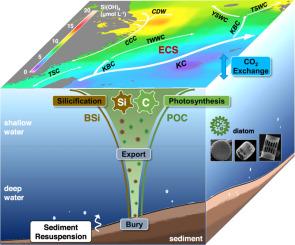Spatial and seasonal dynamics of biogenic silica in a eutrophic marginal sea, the East China Sea
IF 6.3
3区 综合性期刊
Q1 Multidisciplinary
引用次数: 0
Abstract
Biogenic silica (BSi) is a key component of the marine silicon cycle, which is mainly driven by diatom metabolism notably contributing to primary production and export of particulate organic carbon (POC), particularly in ocean margins. Based on a large data set collected in the East China Sea (ECS), including BSi, fucoxanthin (Fuco), POC, and total suspended matter (TSM), we systematically explored the distribution and control of BSi in a typical eutrophic marginal sea. Spatially, BSi concentrations generally decreased from the shelf to the slope during all seasons, because the former is largely fed by river plumes and/or coastal currents enriched in nutrients favoring diatom growth. Abundant BSi was also observed in nearshore bottom waters probably influenced by sediment resuspension indicated by high TSM concentrations. Seasonally, BSi concentrations were on average higher in summer and autumn than in spring and winter, which reflects elevated diatom productivity during warm seasons. The BSi standing stock in the shallow water column of the ECS was significantly correlated with that of Fuco demonstrating diatoms’ dominant control on BSi dynamics. In addition, significant relationships between BSi and POC standing stocks were observed in summer and autumn, indicating the major role of diatoms in C fixation. By comparing with the northern South China Sea (NSCS), we suggested relatively small seasonal variability of BSi on the ECS shelf but significant decrease during cold seasons in the ECS slope. In the latter case, diatoms are ecologically and biogeochemically more important and more sensitive to the changing physical and/or chemical conditions than in the oligotrophic NSCS slope.

东海富营养化边缘海生物成因二氧化硅的空间和季节动态
生物源二氧化硅(BSi)是海洋硅循环的关键组成部分,该循环主要由硅藻代谢驱动,特别是在海洋边缘,它有助于颗粒有机碳(POC)的初级生产和输出。基于东海海域的BSi、岩藻黄质(Fuco)、POC和总悬浮物(TSM)数据,系统探讨了典型富营养化边缘海BSi的分布及其控制。在空间上,BSi浓度在所有季节从陆架到坡面总体呈下降趋势,这是因为陆架主要由富含有利于硅藻生长的营养物的河流羽流和/或海岸流供给。在近岸底水也观察到大量的BSi,可能受到沉积物再悬浮的影响,表明TSM浓度较高。夏季和秋季的BSi浓度平均高于春季和冬季,反映了暖季硅藻生产力的提高。ECS浅水柱的BSi存量与Fuco显著相关,表明硅藻对BSi动态具有显性控制作用。此外,在夏季和秋季,BSi与POC林分存量呈显著相关,表明硅藻在碳固定中起主要作用。与南海北部相比,东大陆架BSi的季节变化相对较小,而东大陆架坡面BSi在寒冷季节显著减少。在后一种情况下,硅藻在生态和生物地球化学上比在贫营养NSCS斜坡中更重要,对变化的物理和/或化学条件更敏感。
本文章由计算机程序翻译,如有差异,请以英文原文为准。
求助全文
约1分钟内获得全文
求助全文
来源期刊

Fundamental Research
Multidisciplinary-Multidisciplinary
CiteScore
4.00
自引率
1.60%
发文量
294
审稿时长
79 days
期刊介绍:
 求助内容:
求助内容: 应助结果提醒方式:
应助结果提醒方式:


